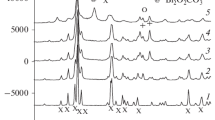Abstract
This paper describes a study on some physico-chemical properties of CuO−Bi2O3 mixed oxides of various composition and their reactivity during hydrogen reduction in the range 290–460°C. Depending on the composition, the changes in the morphology of the samples, their specific surface areas, phase composition of Bi2O3 as well as the change in the amount of chemisorbed surface oxygen (specific surface oxidation ability) were found. The last mentioned parameter is strongly affected positively or negatively (depending on the dose absorbed) by the pre-irradiation with gamma-rays and accelerated electrons. Either reduction of CuO or consecutive reduction of both components with a maximum rate on the surface or sub-surface layers of grain, proceed in different temperature ranges.
The retarding effect of liquid bismuth is partially compensated for by the sponging and trapping effects, so that the overall reduction rate changes non-monotonously with the composition of the samples. Pre-irradiation leads in all cases to the lowering of reduction rate, which can be correlated with the increase in the concentration of strongly bound oxygen forms, creating centres of donor hydrogen chemisorption. The effect of gamma-radiation appears to be function of the threshold dose absorbed.
Zusammenfassung
Vorliegend wird eine Untersuchung der physikalisch-chemischen Eigenschaften von CuO−Bi2O3-Mischoxiden verschiedenster Zusammensetzung und deren Reaktivität bei der Wasserstoffreduktion im Temperaturbereich 290–460°C beschrieben. In Abhängigkeit von der Zusammensetzung, der Morphologie der Proben, deren spezifischer Oberfläche, der Phasenzusammensetzung von Bi2O3 und der Änderung des chemisch gebundenen Oberflächensauerstoffes. Der zuletzt erwähnte Parameter wird durch eine vorherige Bestrahlung mit Gammastrahlung und schnellen Elektronen stark positiv oder negativ (je nach adsorbierter Dosis) beeinflußt. In verschiedenen Temperaturintervallen verlaufen entweder die Reduktion von CuO oder die konsekutive Reduktion beider Komponenten mit einer Höchstgeschwindigkeit an der Oberfläche oder in den unter der Oberfläche liegenden Strukturschichten.
Der Rückhalteeffekt von flüssigem Wismut wird teilweise durch die Bläh- und Fangeffekte ersetzt, so daß die resultierende Reduktionsgeschwindigkeit sich mit der Zusammensetzung der Proben nichtmonoton verändert. Eine vorangehende Bestrahlung führt in allen Fällen zu einer Verringerung der Reduktionsgeschwindigkeit, was durch die Entstehung von Zentren mit Donorwasserstoffchemisorption mit dem Ansteigen der Konzentration stark gebundener Sauerstofformen korreliert. Der Effekt der Gammastrahlung scheint eine Funktion der absorbierten Grenzschwellendosis zu sein.
Similar content being viewed by others
References
M. Egashira, K. Matsuo, S. Kagawa and T. Seiyma, J. Catal. 58 (1979) 409.
J. M. Peacock, A. J. Parker, P. G. Ashmore and J. A. Hockey, J. Catal., 15 (1969) 387.
T. P. Snyder and Ch. G. Hill, J. Catal., 132 (1991) 536.
W. Verhoeven and B. Delmon, Bull. Soc. Chim. France, 10 (1966) 3073.
M. Pospísil and M. Tvrzník, Collect. Czech. Chem. Commun., 40 (1978) 998.
E. Gisquet and M. Destrian, Bull. Soc. Chim. France, 5 (1969) 1455.
M. Pospísil and M. Martykán, Thermochim. Acta, 184 (1991) 159.
S. Weller and E. Volts, J. Am. Chem. Soc., 76 (1954) 4695.
C. W. Beck, Thesis. Harward University, Cambridge, Mass. USA, 1946.
J. L. Jambor, Can. Mineralogist, 8 (1964) 92.
T. Ishii, Tehrmochim. Acta, 137 (1989) 293.
M. Pospísil and J. Topinka, Collect. Czech. Chem. Commun., 51 (1986) 1561.
M. Pospísil, Thermochim. Acta, 119 (1987) 261.
N. Toropovet al., Diagrams of composition of the silicate systems, Nauka, Moscow 1970, p. 204.
V. V. Gromov, Radiat. Phys. Chem., 38 (1991) 343.
M. Pospísil and P. Taras, Collect. Czech. Chem. Commun. 42 (1977) 1266.
W. Bond, J. Phys. Chem., 66 (1962) 1573.
J. Székely, J. Evans and Y. Sohn, Gas-Solid Reaction. Acad. Press, New York, 1976.
W. Verhoeven and B. Delmon, Bull. Soc. Chim. France, 10 (1966) 3065.
Author information
Authors and Affiliations
Rights and permissions
About this article
Cite this article
Pospísil, M. Physico-chemical properties of CuO−Bi2O3 mixed oxides and modification of their hydrogen reduction reactivity by ionizing radiation. Journal of Thermal Analysis 44, 133–146 (1995). https://doi.org/10.1007/BF02547142
Received:
Issue Date:
DOI: https://doi.org/10.1007/BF02547142




